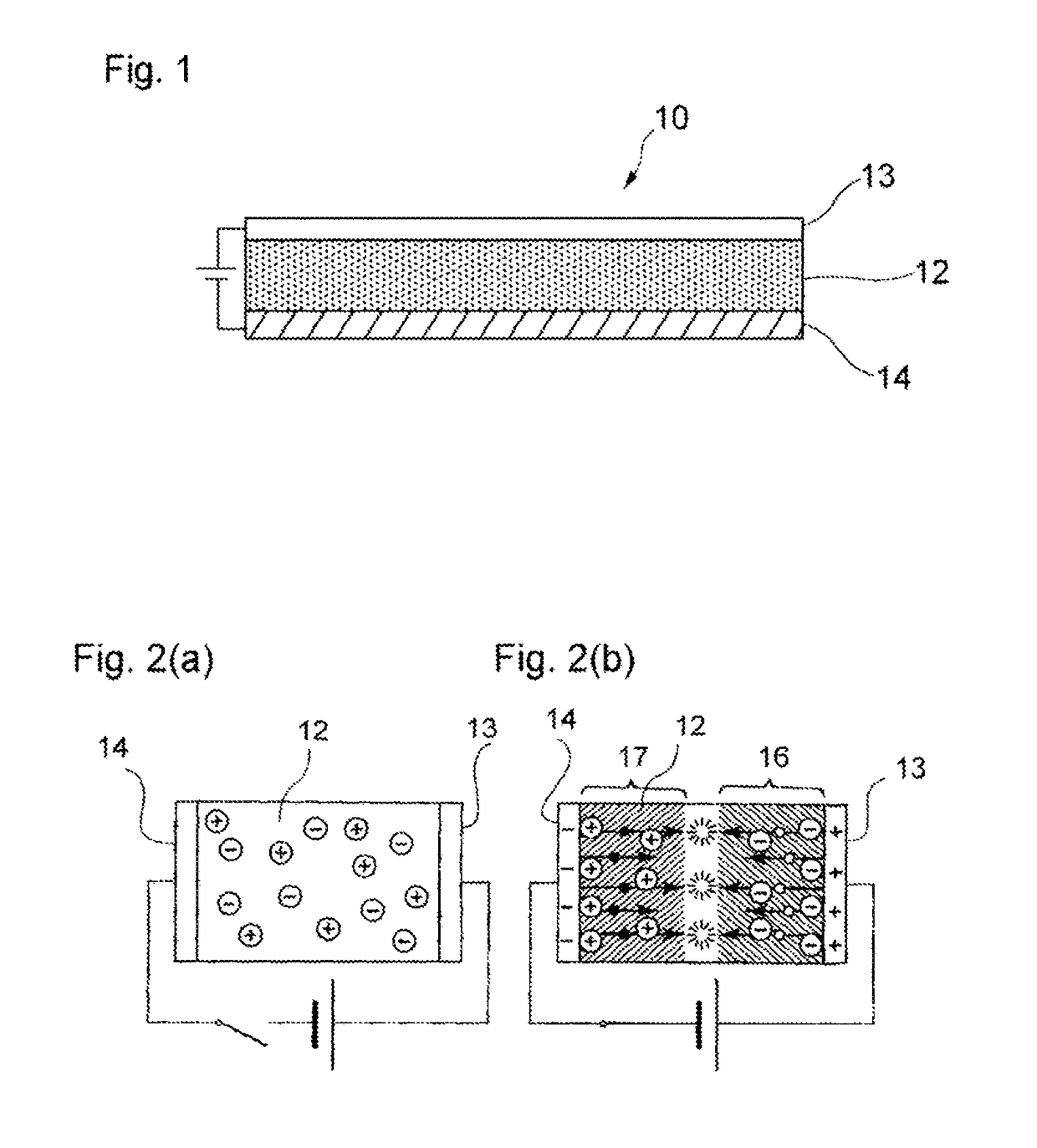Electrochemical light emitting cell, composition for forming light emitting layer of electrochemical light emitting cell, and ionic compound for light emitting layer of electrochemical light emitting cell
a light-emitting cell and electrochemical technology, applied in the field of electrochemical light-emitting cells, can solve the problems of many manufacturing steps, many restrictions in selecting the electrode materials for forming positive and negative electrodes, and the limitation of the electrode materials is not so great, so as to improve the properties of the organic thin film forming the emitting layer, increase the rate of re-arrangement of ions, and improve the effect of the compatibility between the organic ionic compound
- Summary
- Abstract
- Description
- Claims
- Application Information
AI Technical Summary
Benefits of technology
Problems solved by technology
Method used
Image
Examples
examples
[0065]The invention will now be illustrated in greater detail with reference to Examples, but it should be understood that the invention is not deemed to be limited thereto. The characteristics were determined in Examples and Comparative Examples by the following methods.
Determination of Luminance:
(1) In Examples 1 to 20 and Comparative Examples 1 to 10
[0066]The first electrode of the LEC obtained was connected to the positive terminal of a direct current, and the second electrode to the negative terminal. A voltage was applied at a sweep rate of 1 V / sec up to 15 V. The maximum luminance reached during the voltage application was taken as the luminance of the LEC. Measurements were made using a luminance meter CS-2000 from Konica Minolta.
(2) In Examples 21 to 24
[0067]The tint electrode of the LEC obtained was connected to the positive terminal of a direct current, and the second electrode to the negative terminal. A voltage was applied at a sweep rate of 1 V / sec up to 6 V. The lumin...
examples 1 to 15
[0068]Examples in which a phosphonium cation was used as a cations of the ionic compound are presented.
[0069]A commercially available glass substrate coated with an ITO film (ITO film thickness: 200 nm; available from Geomatec) was used as a first electrode 13.
[0070]A mixed solution was prepared using the organic light emitting polymer shown in Table 1 as a light emitting material and the compound shown in Table 1 as an ionic compound. Specifically, an organic light-emitting polymer solution in toluene (conc.: 9 g / l) and an ionic compound solution in toluene (conc.: 9 g / l) were mixed at a volume ratio of 4:1 (the former:the latter) in a glove box filled with argon at mom temperature to prepare an emitting layer-forming composition.
[0071]The emitting layer-forming composition prepared above was applied to the first electrode 13 of the glass substrate by spin coating at room temperature in the glove box filled with argon and dried on a hot plate at 50° C. for 30 minutes to remove the ...
examples 16 to 20
[0072]Examples in which an ammonium cation was used as a cation of the ionic compound are presented.
[0073]A mixed solution was prepared using the organic light-emitting polymer shown in Table 1 as a light-emitting material and the compound shown in Table 1 as an ionic compound. Specifically, an organic light-emitting polymer solution in toluene (conc.: 9 g / l) and an ionic compound solution in toluene (conc.: 9 g / l) were mixed at a volume ratio of 4:1 (the former:the latter) in a glove box tilled with argon at room temperature to prepare an emitting layer-forming composition. An LEC 10 was made in otherwise the same manner as in Example 1. The results of the determination of the emission characteristics of the resulting LEC 10 are shown in Table 1.
PUM
| Property | Measurement | Unit |
|---|---|---|
| thickness | aaaaa | aaaaa |
| thickness | aaaaa | aaaaa |
| thickness | aaaaa | aaaaa |
Abstract
Description
Claims
Application Information
 Login to View More
Login to View More - R&D
- Intellectual Property
- Life Sciences
- Materials
- Tech Scout
- Unparalleled Data Quality
- Higher Quality Content
- 60% Fewer Hallucinations
Browse by: Latest US Patents, China's latest patents, Technical Efficacy Thesaurus, Application Domain, Technology Topic, Popular Technical Reports.
© 2025 PatSnap. All rights reserved.Legal|Privacy policy|Modern Slavery Act Transparency Statement|Sitemap|About US| Contact US: help@patsnap.com



